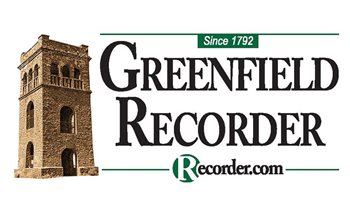Greenfield ZBA concludes cell tower hearing

Engineer Michael Lawton speaks about gaps in cell coverage near the proposed Newton Street cell tower during a Greenfield Zoning Board of Appeals meeting on Wednesday. STAFF PHOTO/ANTHONY CAMMALLERI
| Published: 06-05-2025 4:09 PM |
GREENFIELD — After six months, the Zoning Board of Appeals wrapped up its public hearing Wednesday regarding whether to grant a variance allowing Viridi Wireless to build a 170-foot AT&T cell tower near 112 Newton St.
In a roughly four-hour meeting, the ZBA heard testimony from Michael Lawton, a peer review engineer, about gaps in cell coverage. The board will meet again on June 18 to decide whether to grant the applicant a variance.
When the cell tower proposal was first brought before the ZBA in December, there was pushback from community members who are concerned with its appearance, as well as potential health and safety risks.
Since then, the board has heard testimony from numerous individuals, including Fire Chief Robert Strahan and Dr. Kent Chamberlain, of New Hampshire’s Commission to Study the Environmental and Health Effects of Evolving 5G Technology.
Those in opposition to the cell tower, such as attorney Andrew Campanelli, who was hired by a group of residents who are opposed to the tower’s construction, previously refuted the coverage gaps presented by AT&T, arguing that dropped call data was the “gold standard” to measure a coverage gap.
Lawton, when asked about dropped call data, said that while it could be an important tool for measuring a gap in cell reception, it is no longer the most accurate for measuring coverage, as modern communication uses digital transmission and reception relies on alternative factors such as locations and structures.
“There’s a spectrum of information that’s been provided here, from things that are definitely factual to a lot of things that may be more emotional than factual and more conjecture than factual,” Lawton said before he presented drive test data showing coverage gaps. “Dropped call data, 10 years ago, was a very useful tool in your toolbox to determine whether coverage existed or not. As the technology has evolved, dropped call data is becoming less and less meaningful and less and less useful.”
Because the proposed cell tower site does not have a sufficient “fall zone,” or cleared ground area on which the tower could safely land in the event of a structural failure, the applicant had to apply for a variance.
Article continues after...
Yesterday's Most Read Articles
 Erving man, 60, found dead in Montague Plains Wildlife Management Area identified
Erving man, 60, found dead in Montague Plains Wildlife Management Area identified
 Chicopee man, 21, drowns at Conway Community Swimming Pool
Chicopee man, 21, drowns at Conway Community Swimming Pool
 Greenfield residents concerned with condo proposal
Greenfield residents concerned with condo proposal
 Marine vet becomes Blessed Trinity Parish’s newest priest in Greenfield
Marine vet becomes Blessed Trinity Parish’s newest priest in Greenfield
 Chicopee man who drowned in Conway identified
Chicopee man who drowned in Conway identified
 ‘Now it feels like a village’: Chaos Corner in Millers Falls changing ownership
‘Now it feels like a village’: Chaos Corner in Millers Falls changing ownership
“This tower is not within the fall zone of any house or structure,” said attorney Michael Rosen, who represents Viridi Wireless. “It is hundreds and hundreds of feet away from any home. If it fell, it would fall over the road.”
After numerous engineers explained the rarity of monopole structures falling, as well as the tower’s “pinch point” design feature — which causes the tower to fold in half, rather than fall, in the event of failure — ZBA member Peter Wozniak said he was comfortable with the proposed cell tower’s structural safety.
“I have a structural engineer who’s licensed approving the design, a peer review done by a professional engineer and another peer review. I’m comfortable with that recommendation,” Wozniak said. “This is what I’ve been doing my entire career. … I heard three engineers tell me it was satisfactory. I hear that and I believe it.”
In 2017, the federal government designated AT&T the carrier of FirstNet, or the First Responder Network Authority, making the company the primary provider for emergency service agencies. In a brief public comment period, abutting resident and FirstNet user Andrew Vernon and his wife Jennifer Vernon said they experience lapses in coverage in and around their Sunset Square home.
“My calls drop constantly. I’ve got two children and I also go to [Greenfield Community College]. We have the same problem there. I go for walks around my neighborhood, I’m in that drop zone. It’s just reality,” Jennifer Vernon said. “I can understand [AT&T] wanting to give other people a better service. I really would love better service.”
Others, such as South Shelburne Road resident Elana Kirshenbaum, who organized the community group opposing the cell tower, said she was not pleased with the evidence the wireless communication company shared to prove the tower’s necessity and safety.
“There are still too many unproven and unresolved questions regarding the need and safety of this tower. There are also too many essential data reports that significantly differ from one another, including engineering reports,” Kirshenbaum said. “I join the other Greenfield residents in urging that you deny the variance for this tower.”
Anthony Cammalleri can be reached at acammalleri@recorder.com or 413-930-4429.






 Gov. Healey forms Anti-Hunger Task Force in response to federal SNAP cuts
Gov. Healey forms Anti-Hunger Task Force in response to federal SNAP cuts Firefighters partner with Jumptown to practice water rescues in Orange
Firefighters partner with Jumptown to practice water rescues in Orange South County reporter bids adieu after four years
South County reporter bids adieu after four years Fire chiefs, local officials advocate for new building authority
Fire chiefs, local officials advocate for new building authority
